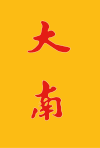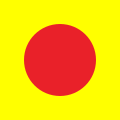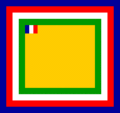Flags are special symbols that tell a story about a country, its history, and its people. Vietnam has a rich history, and because of that, it has had many different flags over time. This article will show you some of the most important flags of Vietnam, from the official national flag to historical banners and flags used by different groups.
The National Flag
The national flag is the most important flag for any country. It represents the whole nation.
Current National Flag
Official Flag
The current official flag of Vietnam is bright red with a large yellow star in the middle.
| Flag |
Date |
What it's used for |
Description |
 |
July 2, 1976 – today |
State flag and civil flag |
This flag has a big yellow star in the center of a red background. The red color stands for revolution and the sacrifices made. The golden star represents the five main groups of people in Vietnamese society: thinkers, farmers, workers, business people, and soldiers. |
Overseas Vietnamese Flag
Some Vietnamese people living outside of Vietnam use a different flag.
| Flag |
Date |
What it's used for |
Description |

A yellow flag with three red stripes.
|
1975 – today |
Often used by Vietnamese people living in other countries. |
This flag has a yellow background with three horizontal red stripes. Yellow is a traditional color for Vietnam. The three red stripes represent the three main regions of Vietnam: North, Central, and South. This flag was once the flag of South Vietnam. It is not allowed to be used in Vietnam today. |
Historical National Flags
Vietnam has had many national flags throughout its history, reflecting different periods and governments.
| Flag |
Date |
What it was used for |
Description |
 |
Around 1858 – 1885 |
The flag used for diplomatic meetings by the Empire of Đại Nam. |
A yellow flag with a gold border. |
 |
1885 – March 9, 1945 |
The flag of the French protectorates of Annam and Tonkin. |
This flag had a French flag in the top left corner on a yellow background. It was used as the government flag. |
 |
Around 1941 – June 12, 1945 |
Flag of Đại Nam and the Empire of Vietnam. |
A yellow flag with one large red stripe across it. |
 |
June 12 – August 30, 1945 |
Flag of the Empire of Vietnam. |
A yellow flag with four red stripes that formed a special symbol called the Quẻ Ly. |
 |
September 2, 1945 – November 30, 1955 |
Flag of the Democratic Republic of Vietnam (North Vietnam). |
A large yellow star in the center of a red flag. |
 |
June 2, 1948 – July 2, 1949
July 2, 1949 – April 30, 1975 |
Flag of the Provisional Central Government of Vietnam, the State of Vietnam, and the Republic of Vietnam (South Vietnam). |
A yellow flag with three red stripes. This flag was adopted by Chief of State Bảo Đại. |
Imperial Flags
These flags were used by emperors and their royal families.
| Flag |
When it was used |
What it was used for |
Description |
 |
Around 1885–1890 |
Flag of Emperor Đồng Khánh. |
A flag with the words Đại Nam (meaning "Great South") on it. |

A red flag with a single yellow stripe.
|
Around 1890–1920 |
Flag of Emperors Thành Thái, Duy Tân, and Khải Định. |
A red flag with a single yellow stripe. |

A yellow flag with a single red stripe.
|
Around 1920–1945 |
Flag of Emperors Khải Định and Bảo Đại. |
A yellow flag with a single red stripe. This was sometimes called the "Dragon star flag." |
Personal Flags of Emperors
These flags were specifically for the emperors themselves.
| Flag |
When it was used |
What it was used for |
Description |
 |
1922–1945 |
Personal flag of Emperors Khải Định and Bảo Đại. |
The flag had a ratio of 2:3. |

Personal flag of State Chief Bảo Đại.
|
1948–1955 |
Personal flag of State Chief Bảo Đại. |
The flag had a ratio of 2:3. |
Presidential Flags
These flags were used by the presidents of South Vietnam.
| Flag |
When it was used |
What it was used for |
Description |
 |
1955–1963 |
Presidential flag of the First Vietnamese Republic. |
A yellow flag with green bamboo at the top and red words "Tiết-trực tâm-hư" (meaning "honest and modest") at the bottom. |
 |
1964–1975 |
Presidential flag of the Second Vietnamese Republic. |
A white flag with the coat of arms (symbol) of the Republic of Vietnam in the middle. |
Political Flags
Many different political groups and parties in Vietnam's history have had their own flags. Here are a few examples.
| Flag |
When it was used |
What it was used for |
Description |
 |
1910–1930 |
Flag of the Indochinese Constitutionalist Party. |
A yellow flag with a red "X" shape in the center. |

Flag of the Communist Party of Vietnam.
|
1930– |
Flag of the Communist Party of Vietnam. |
This flag is red with a yellow hammer and sickle symbol, representing workers and farmers. |

Flag of the League for the Independence of Vietnam.
|
1941–1951 |
Flag of the League for the Independence of Vietnam (Việt Minh). |
A yellow star in the center of a red flag. |

Flag of the Vanguard Youth.
|
1945 |
Flag of the Vanguard Youth. |
A red star in the center of a yellow flag. |

Flag of the National Liberation Front for South Vietnam.
|
1960–1977 |
Flag of the National Liberation Front for South Vietnam. |
A yellow star on a flag that is half red and half blue. |
Religious Flags
Different religions in Vietnam also have their own special flags.
-
The Five-color flag, often used in festivals.
-
Flag of the Catholic Church in Vietnam.
-
Flag of Cao Đài, a unique Vietnamese religion.
-
Flag of the Evangelical Church of Vietnam.
-
Flag of Hòa Hảo, another Vietnamese religious group.
-
Flag of the Unified Buddhist Sangha of Vietnam and Vietnam Buddhist Sangha.
Military Flags
The military forces of Vietnam have their own flags to represent different branches and units.
| Flag |
Date |
What it's used for |
Description |
| Current Military Flags |
 |
1955–today |
Flag of the People's Army of Vietnam. |
A yellow star in the center of a red flag, with the yellow words "Quyết thắng" (meaning "determined to win") in the top left corner. |

Flag of the Vietnam People's Navy.
|
1955–today |
Flag of the Vietnam People's Navy. |
This flag is similar to the People's Army flag but has the name of the Navy at the bottom. |

Flag of the Vietnam People's Air Force.
|
1959–today |
Flag of the Vietnam People's Air Force. |
This flag is similar to the People's Army flag but has the name of the Air Force at the bottom. |
| Historical Military Flags |

Flag of the Liberation Army of South Vietnam.
|
1961–1976 |
Flag of the Liberation Army of South Vietnam. |
A yellow star in the center of a flag that is half red and half blue, with the yellow words "Quyết thắng" in the top left corner. |

War flag of the Republic of Vietnam.
|
1965–1975 |
War flag of the Republic of Vietnam (South Vietnam). |
A yellow flag with three red stripes and a gold eagle in the middle. |
Police Flags
Police forces in Vietnam also have their own flags.
| Flag |
Date |
What it's used for |
Description |
| Current Police Flags |
 |
1955–today |
Flag of the Vietnam People's Public Security. |
A yellow star in the center of a red flag, with the yellow words "Bảo vệ an ninh tổ quốc" (meaning "Protecting the Fatherland's Security") in the top left corner. |
| Historical Police Flags |

Flag of the Republic of Vietnam National Police.
|
1955–1975 |
Flag of the Republic of Vietnam National Police. |
A green flag with the motto "Tổ quốc, Công minh – Liêm chính" (meaning "Fatherland, Justice – Integrity") at the top, the police badge in the middle, and the name "Cảnh sát Quốc gia" (National Police) at the bottom. |
Naval Flags (Ensigns)
Ensigns are flags flown on ships to show their nationality.
| Flag |
Date |
What it's used for |
Description |
| Historical Naval Flags |
 |
1923–1945
1945–1949 |
Civil and Naval Ensign of French Indochina. |
A yellow flag with a French flag in the top left corner and a swallowtail shape (cut out at the end). |

Naval ensign of South Vietnam.
|
1952–1975 |
Naval ensign of the State of Vietnam and the Republic of Vietnam. |
A yellow flag with three red stripes and an anchor in the middle. |
| Current Naval Flags |

Ensign of the Vietnam Coast Guard.
|
1998–today |
Ensign of the Vietnam Coast Guard. |
A dark blue flag with the Vietnamese national symbol in the middle and a yellow arrow pointing towards the flagpole. |

Naval ensign of the Vietnam People's Navy.
|
2014–today |
Naval ensign of the Vietnam People's Navy. |
A white flag with the symbol of the Vietnam People's Navy at the top and a blue stripe below. |
Flags of Vietnamese Regions and Ethnic Groups
Different areas and ethnic groups within Vietnam have also used their own flags.
Provinces of the Nguyễn Dynasty
These flags were used by different provinces during the Nguyễn dynasty.
Areas with Special Status and Ethnic Minorities
Some regions and ethnic groups have had unique flags.
| Flag |
When it was used |
What it was used for |
Description |
 |
1946 |
Flag of the Autonomous Republic of Cochinchina. |
A yellow flag with two yellow stripes and three blue stripes. |

Flag of the Kingdom of Sedang.
|
1888–1889 |
Flag of the Kingdom of Sedang. |
A white cross in the center of a blue flag. |

Flag of the Tai Dón people.
|
1944–1953 |
Flag of the Tai Dón people. |
A large red square in the center of a yellow flag. |

Flag of the Hmong people.
|
1993— |
Flag of the Hmong people. |
This flag features a white circle with a green border on a red background. |
City Flags
Some cities in Vietnam have their own flags, though not all are official.
| Flag |
When it was used |
What it's used for |
Description |

Decorative flag for Hanoi.
|
? |
Decorative flag for Hanoi. |
The symbol of Hanoi in gold on a red flag, similar to the national flag. |

Unofficial flag of Haiphong.
|
? |
Unofficial flag of Haiphong. |
The seal of Haiphong (a flower) on a white flag with two red stripes at the top and bottom. |
Other Flags
Company Flags
Some state-owned companies in Vietnam have their own flags.
| Flag |
When it was used |
What it's used for |
Description |
 |
1994-today |
Flag of Vietnam Electricity (EVN). |
A blue flag with the EVN company logo. |
 |
1988-today |
Flag of the Vietnam Bank for Agriculture and Rural Development (Agribank). |
A red flag with the Agribank logo and its full name. |
Organization Flags
Different organizations in Vietnam also have their own flags.
| Flag |
When it was used |
What it's used for |
Description |

Flag of the Vietnam Red Cross.
|
1946-today |
Flag of the Vietnam Red Cross. |
A white flag with the logo of the Vietnam Red Cross Association. |

Official flag of the Vovinam Association.
|
1990s-today |
Official flag of the Vovinam Association. |
A yellow flag with the Vovinam symbol in the middle and text at the top and bottom. |
Cultural Flags
These flags are used for cultural events, traditions, or to represent certain ideas.
| Flag |
When it was used |
What it's used for |
Description |
 |
|
Vietnamese five-color flags. |
These flags have five colorful squares inside each other (red, green, yellow, and blue). They are used in festivals and religious ceremonies. |
 |
April 30, 1975– |
"Vietnamese Heritage and Freedom Flag". |
This yellow flag with three red stripes is still used by some Vietnamese people living outside Vietnam, especially those who left after the Fall of Saigon. |
Monarchist Flags
These flags are used by groups who support the idea of having a king or emperor again in Vietnam.
| Flag |
When it was used |
What it's used for |
Description |
 |
|
Vietnamese monarchist flag with a blue dragon. |
This flag features a blue Vietnamese dragon on a yellow background with three red stripes. |

Vietnamese monarchist flag with a green dragon.
|
|
Vietnamese monarchist flag with a green dragon. |
This flag features a green dragon on a yellow background with three red stripes. |
Proposed National Flags
Over time, different people have suggested new designs for Vietnam's national flag.
| Flag |
First suggested |
Name / Suggested by |
Description |

A proposed flag for Vietnam.
|
Around 1912–1925 |
The Quốc kỳ Ngũ Tinh ("Five stars national flag") by Phan Bội Châu. |
This flag had five red dots connected by an "X" shape on a yellow background. |

The Reconciliation Flag of Vietnam.
|
January 17, 1973 |
The Reconciliation Flag of Vietnam. |
This flag has vertical stripes of yellow, green, and red, with a white 12-pointed star in the center. The colors and star points have special meanings related to peace and freedom. |
Images for kids
-
Viet Minh battle flag during the First Indochina War.
-
Flag of Republic of Vietnam Marine Division.
-
Flag of Vietnamese National Army.
-
Military flag of Annam (French protectorate).
-
Flag of the royal cavalry of the Nguyễn dynasty.
-
Flag of the Việt Nam Quang phục quân.
-
Flag of the Army of the Nguyễn dynasty.
-
See also
































































